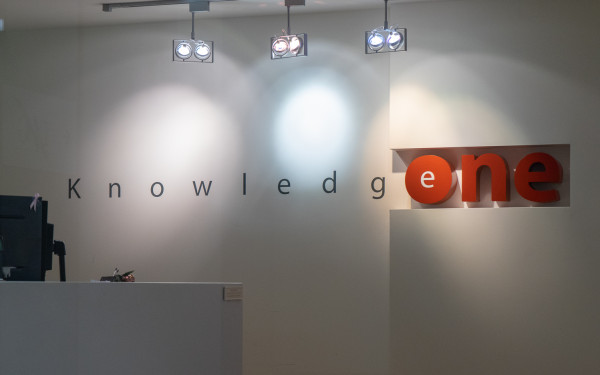Concordia e.SCAPEs the Classroom
E-Learning Conference Promises Teaching Shakeups
Universities around the world are suffering some growing pains.
To put it simply, what’s the point of classroom chats in the era of virtual check-ins?
Higher education is playing catch-up with technology, but at Concordia last week, e-learning enthusiasts from around the world were willingly sharing their secrets on how to get ahead of the curve.
“What technology does is that it forces you to open up your horizons and your mind, and creates new possibilities,” said Concordia Vice-Provost, Teaching and Learning Ollivier Dyens, paraphrasing famed technology scholar Kevin Kelly.
“We’re going to look into augmented reality, we’re going to look into gesture-based computing—all of these things we’re going to look into, because they have forced us to really think about what is a 21st-century university.”
But while some speakers at Concordia’s inaugural e.SCAPE conference explored these technologies—including videogames, synchronous online classes and even social media—others were there to provide refresher material for e-learning tools students are already using.
Multiple info sessions on Moodle 2.3, the latest release of the online communication tool already used extensively at Concordia, ran each day of the three-day conference.
e-Learning ≠ eConcordia
Other seminars sought to bridge the gap between in-class and e-learning by advising professors on how to create online courses at Concordia.
Since its inception in 2000, eConcordia—a for-profit corporation set up in adjunct to the university—has been offering accredited courses online in partnership with Concordia.
Growing from close to 10 courses in 2006, 53 credited courses were available this winter semester.
The online entity now accounts for 15 per cent of university enrolment, with about 33,000 unique students registered to take e-courses.
According to Concordia professor and e-learning fellow Saul Carliner, classes are proposed by professors to their department and usually cost around $50,000 to develop.
Concordia is also hoping to offer massive open online courses, or MOOCs, for the world outside its own student body.
MOOCs emerged as an online teaching format as early as 2008, but did not gain significant attention until 2011.
Major projects, such as Coursera and edX—a joint venture between Harvard University and the Massachusetts Institute of Technology, in partnership with other institutions such as UC Berkeley and McGill University—now offer classes with over 100,000 students enrolled.
In an interview with The Link in March, Concordia President Alan Shepard explained that while MOOCs have a notoriously high dropout rate, the platform is still in its infancy.
And while the courses will be widely accessible, MOOCs are not applicable to a Concordia degree.
“They are going to get no formal academic credentials even if they complete [the class], so the carrot at the end of the stick is all about intellectual development,” said Shepard.
Traditional, face-to-face classes are upgradable as well. According to Shepard, Concordia is also looking into developing more “blended” courses: a mixture between conventional teaching and online multimedia tools.
To Shepard, blended courses are a growing trend that seems to have long-term staying power.
But Dyens says that for the university to be successful, patience and caution are also needed.
“Concordia is too large to go ahead all the way right now, so we have to move carefully using pilot projects with people who are interested,” he explained.
According to Dyens, the university will introduce beta-tested courses, or BTCs, in September, in which professors and interested students will collaborate to develop that class’s final materials and structure.
BTCs will not be graded—it’s pass/fail for students—and will be clearly marked to ensure uninterested parties do not mistakenly enter the trial class, he added.
Digi-Bag of Tricks
Adventurers who do decide to participate in BTCs will be able to experiment utilizing augmented reality and, surprisingly, video games.
“Some of the most forward-looking, innovative or even edgy ideas are things we will consider because they’re interesting, and I think games are one of the big things we’re trying right now,” said Dyens.
But there are some at Concordia that have already incorporated both technologies.
The interdisciplinary Topological Media Lab affiliated with the Hexagram-Concordia Centre for Research-Creation in Media Arts and Technologies on campus already utilizes gestural sound and video that varies according to movement.
In communication studies, students are already making their own video games to explore the ethical consequences of human choices.
According to Dr. Mia Consalvo, the Canada Research Chair in Game Studies and Design, video games formatted to allow for choices to affect gameplay are easily translatable to commerce, particularly marketing and economics.
“You don’t normally see students say, ‘Hey, I showed my friends my final project and made them play it,’” admitted Consalvo during her e.SCAPE seminar on April 5.
“It was such a wonderful moment for [them] to get this game to work and it gave each of us an achievement, an accomplishment.”
But while Dyens is optimistic about using games in academia, technology should be shaped by the subject matter.
Some areas of study are not suitable for videogames, he concluded.
“The goal here is not to use technology for technology’s sake, but really to use technology so it enhances the student and the faculty experience,” Dyens said.
“That’s the whole point here.”

_900_600_90.jpg)
_600_832_s.png)

(WEB)_600_375_90_s_c1.jpg)
_600_375_90_s_c1.jpg)
(WEB)_600_375_90_s_c1.jpg)
